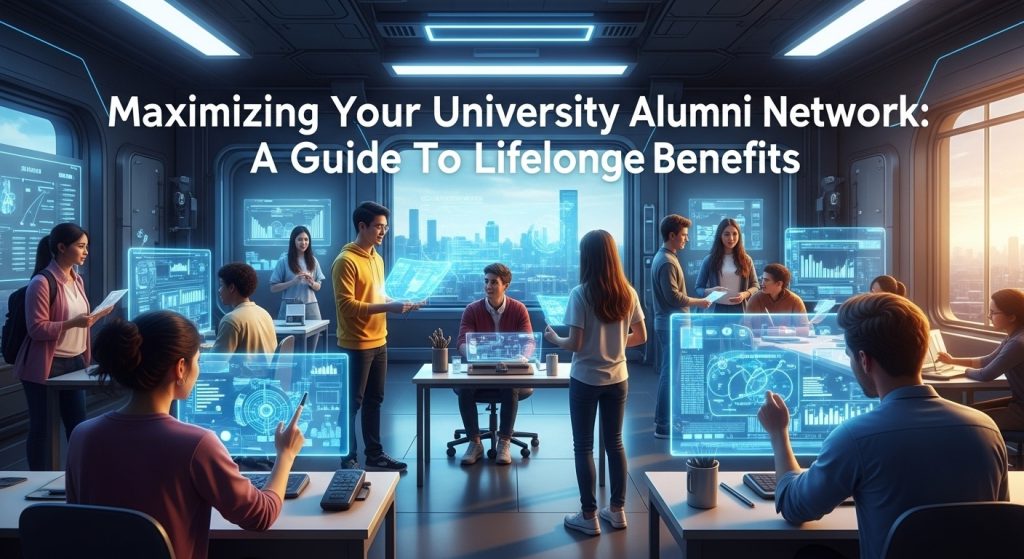Navigating the complex landscape of higher education demands strategic foresight, especially as global economies rapidly pivot towards automation, artificial intelligence. The green transition. Selecting a university course transcends mere academic interest; it represents a critical investment in your future professional trajectory and personal growth. With the advent of fields like AI ethics, quantum computing. Sustainable energy systems, understanding the long-term relevance and transferable skill acquisition of any program becomes paramount. This choice shapes your capacity to adapt to unforeseen market shifts, develop specialized competencies. Ultimately, thrive in a dynamic, interconnected world. Optimizing this decision requires a data-informed approach, integrating personal aptitude with projected industry demands, ensuring your academic path strategically aligns with an evolving career ecosystem.

The Journey Begins: Self-Discovery and Introspection
Choosing a university course is one of the most significant decisions you’ll make, shaping not just your academic path but your future career and personal growth. It’s a journey that starts not with browsing university brochures. With a deep dive into yourself. Before you can choose the perfect course, you need to grasp what “perfect” means for you.
Understanding Your Core: Interests, Strengths. Values
Your first step is self-assessment. This isn’t just about what subjects you enjoy in school. A more profound look at your innate curiosities, talents. What truly drives you.
- Interests: What topics genuinely excite you? What do you find yourself researching or reading about in your free time? Do you love problem-solving, creative expression, understanding human behavior, or delving into scientific principles? If you’re passionate about environmental issues, a course in environmental science or sustainability might be a natural fit. If you’re fascinated by how businesses operate, a business or economics course could be ideal.
- Strengths (Personal Aptitude): What are you naturally good at? Are you analytical, creative, a strong communicator, detail-oriented, or a natural leader? Do you excel in mathematics, writing, artistic endeavors, or practical skills? For instance, someone with a strong aptitude for logical reasoning might thrive in an engineering or computer science course, while a person with excellent interpersonal skills could excel in a psychology or social work course.
- Values: What principles are most crucial to you? Do you value making a social impact, financial stability, innovation, creativity, or work-life balance? Your values should align with the potential career paths a course might open up. If contributing to society is paramount, a course in public health or education might resonate more than a purely commercial one.
Actionable Takeaway: Dedicate time to self-reflection. Keep a journal, talk to trusted mentors, or even take online aptitude tests. Ask yourself: “What truly energizes me?” and “What problems do I enjoy solving?” This foundational understanding of your personal aptitude will be your compass for navigating the vast sea of university course options.
Navigating the Academic Landscape: Exploring Course Options
Once you have a clearer picture of yourself, it’s time to explore the academic world. The sheer number of university courses can be overwhelming. Approaching it systematically will help.
Understanding Different Types of Courses and Fields
University courses come in various forms, each designed to achieve different learning outcomes and career preparations.
- Bachelor’s Degrees: These are typically 3-4 year undergraduate courses (e. G. , Bachelor of Arts (BA), Bachelor of Science (BSc), Bachelor of Engineering (BEng)). They provide comprehensive knowledge in a specific field, preparing you for professional careers or further postgraduate study.
- Diplomas and Certificates: Often shorter (1-2 years), these courses are more focused on practical skills and specific vocational training, leading directly to employment in particular trades or industries.
- Foundation Years/Courses: Some universities offer a preliminary year for students who may not meet the direct entry requirements for a bachelor’s course or who want to bridge knowledge gaps before committing to a full degree.
- Interdisciplinary Courses: These courses combine elements from two or more traditional disciplines (e. G. , Biomedical Science, Digital Humanities, Environmental Economics). They are excellent for students with diverse interests who want a broader perspective.
Comparison of Course Types:
| Course Type | Duration (Typical) | Focus | Career Path Orientation |
|---|---|---|---|
| Bachelor’s Degree | 3-4 years | Comprehensive academic knowledge & critical thinking | Professional careers, postgraduate study |
| Diploma/Certificate | 1-2 years | Practical skills, vocational training | Direct entry into specific trades/industries |
| Interdisciplinary Course | 3-4 years | Broad understanding across multiple fields | Diverse roles requiring adaptable skills |
Researching Specific Fields and Their Applications
Dive into fields that align with your interests. If you’re interested in technology, explore various computer science courses (e. G. , AI, cybersecurity, software engineering), data technology, or data science. If you love helping people, look into medicine, nursing, psychology, social work, or education. Each course has a distinct structure and leads to different real-world applications.
For example, a student interested in solving global challenges might consider a course in International Relations, which could lead to careers in diplomacy, international development, or policy analysis. Conversely, a passion for creative expression might lead to a Fine Arts course, opening doors to careers as an artist, designer, or art therapist.
Actionable Takeaway: Create a shortlist of 3-5 broad areas of study that pique your interest. Then, research specific courses within those areas. Look at university websites, course catalogs. Online forums to grasp the typical course content and potential career paths for each specific course.
Beyond the Prospectus: Diving Deep into University and Course Details
The glossy brochures and online descriptions are just the beginning. To truly grasp a course and its environment, you need to dig deeper.
Curriculum, Teaching Styles. Faculty Expertise
The “course structure” is critical. Don’t just look at the course title; examine the specific modules or subjects taught each year. Is there a good balance of theoretical knowledge and practical application? Does the course offer opportunities for internships, project work, or study abroad? Some courses are highly specialized from the start, while others offer more flexibility in the first year before you choose a specialization.
Consider the teaching style: Do they emphasize lectures, seminars, group projects, or independent research? Your preferred learning style should match the university’s approach. Research the faculty who will be teaching your chosen course. What are their areas of expertise? Are they active researchers? Their reputation and research focus can significantly enhance your learning experience.
Case Study: Emily was torn between two psychology courses. University A had a slightly higher ranking but focused heavily on theoretical research methods. University B, while lower-ranked, offered more practical modules in counseling and clinical psychology, which aligned perfectly with Emily’s goal of working directly with people. She chose University B after speaking to current students who praised the hands-on approach and the faculty’s real-world experience. This decision proved invaluable for her career aspirations.
Campus Culture, Student Support. Alumni Networks
The university environment itself plays a huge role in your success and well-being. Consider the campus culture: Is it large or small, urban or rural, diverse or homogenous? Does it feel collaborative or competitive? Attending open days and virtual tours. Speaking to current students, are invaluable for getting a feel for the atmosphere.
Investigate the student support services. Does the university offer robust academic advising, mental health support, career counseling. Disability services? These resources can be crucial during challenging times.
Finally, look into the alumni network. A strong alumni network can provide invaluable mentorship, internship opportunities. Career connections after you complete your course. Many universities highlight their successful alumni as a testament to the quality of their courses and the career prospects they offer.
Actionable Takeaway: Create a checklist of specific questions about the course content, teaching methods. Campus environment. Visit campuses if possible, or engage deeply with virtual tours and online Q&A sessions. Reach out to current students or recent graduates through online forums or university-sponsored events to get an unfiltered perspective on the course and university life.
Future-Proofing Your Choice: Career Prospects and Employability
While passion and interest are paramount, it’s also practical to consider where your chosen course might lead professionally. This doesn’t mean choosing a course solely for its perceived job prospects. Rather understanding the landscape.
Job Market Trends and Graduate Outcomes
Research the typical career paths for graduates of your chosen course. What industries do they enter? What roles do they take on? Look at official university data on “graduate outcomes” – this often includes statistics on employment rates, average starting salaries. Further study percentages six months or one year after graduation. Reputable sources like government labor statistics bureaus or higher education data providers (e. G. , HESA in the UK, NCES in the US) can provide valuable insights into job market trends and demand for certain skills.
Consider the long-term relevance of the skills you’ll gain. Will the course equip you with transferable skills (critical thinking, problem-solving, communication) that are valuable across various sectors, even if the specific job market for your degree changes?
Internships, Work Placements. Career Services
A good university course will often integrate practical experience. Does the course offer mandatory or optional internships, work placements, or industry projects? These experiences are invaluable for gaining real-world skills, building a professional network. Enhancing your employability after graduation. Some universities have dedicated career services that help students find placements, prepare for interviews. Connect with employers. A strong career service department can significantly boost your post-graduation prospects for any course.
Actionable Takeaway: Investigate the career support offered by the university. Look for testimonials from alumni about their job search experience. Attend career fairs (even virtual ones) to speak with employers who hire graduates from the courses you’re considering. Interpret that while a specific course can guide you, your initiative in seeking internships and networking will also play a huge part in your career journey.
The Practicalities: Financial Considerations and Location
Beyond academic and career considerations, the logistical and financial aspects of choosing a university course are crucial and often determine feasibility.
Tuition Fees, Living Costs. Financial Aid
University education is an investment. Interpret the full cost of your chosen course, which includes not just tuition fees but also living expenses (accommodation, food, transport, books, personal spending). These costs can vary significantly between universities, cities. Even specific courses due to different resource requirements.
Explore all available financial aid options. These can include:
- Scholarships: Merit-based (academic excellence, artistic talent, athletic achievement) or need-based.
- Grants: Often need-based, typically do not need to be repaid.
- Student Loans: Government-backed or private loans that need to be repaid after graduation.
- Bursaries: Financial awards from the university, often based on specific criteria or financial need.
Many universities have dedicated financial aid offices that can help you navigate these options. It’s vital to apply for financial aid early, as deadlines can be strict.
Impact of Location on Lifestyle and Opportunities
The location of the university and your chosen course will significantly impact your daily life. Do you prefer a bustling city, a quiet town, or a campus that feels like its own community? Consider factors like:
- Proximity to Home: Do you want to be close to family or experience living far away?
- Cost of Living: Major cities typically have higher living costs than smaller towns.
- Part-time Work Opportunities: Are there ample opportunities for part-time jobs if you need to supplement your income?
- Industry Connections: Is the university located in an area with industries relevant to your chosen course? For example, a tech course might benefit from being near a tech hub.
- Social Life and Amenities: Does the location offer the kind of social activities, cultural experiences. Amenities you desire?
Actionable Takeaway: Create a detailed budget for each university and course you’re considering. Research available scholarships and financial aid specific to those institutions and courses. Visit the surrounding area (if possible) or research it extensively online to ensure the location aligns with your lifestyle preferences and practical needs.
Making the Informed Decision: Synthesizing and Strategizing
You’ve done the introspection, the research. The practical analysis. Now it’s time to bring all that data together to make your final decision on the perfect university course.
Weighing Pros and Cons: The Decision Matrix
A decision matrix can be an incredibly useful tool for objectively comparing your top choices. List your most crucial criteria (e. G. , course content, career prospects, faculty reputation, location, cost, campus culture, student support). Assign a weight to each criterion based on its importance to you (e. G. , 1-5, with 5 being most essential). Then, score each university/course against each criterion. Multiply the score by the weight to get a weighted score. Sum them up. The course with the highest total score might be your best fit.
Example of a simplified Decision Matrix:
| Criteria | Weight (1-5) | Course X Score (1-5) | Course X Weighted Score | Course Y Score (1-5) | Course Y Weighted Score |
|---|---|---|---|---|---|
| Course Content Alignment | 5 | 4 | 20 | 5 | 25 |
| Career Prospects | 4 | 5 | 20 | 3 | 12 |
| Faculty Reputation | 3 | 4 | 12 | 4 | 12 |
| Location | 2 | 3 | 6 | 5 | 10 |
| Cost (Affordability) | 5 | 3 | 15 | 2 | 10 |
| Total Score | – | – | 73 | – | 69 |
In this example, Course X would be the preferred option based on the weighted criteria.
Seeking Advice and Trusting Your Gut
While data and logic are vital, don’t underestimate the power of your intuition. After all the research, how does each course feel? Does it excite you? Do you feel a sense of belonging when you imagine yourself there?
Talk to people who have been through the process: parents, teachers, school counselors, university alumni. Current students. They can offer valuable perspectives and insights that you might have overlooked. But, remember that ultimately, this is your decision. What’s right for someone else might not be right for you. A good university course for one person might be a poor fit for another due to differing personal aptitudes and aspirations.
Case Study: Alex had narrowed his choices down to two engineering courses. University A was highly prestigious. A visit made him feel overwhelmed by its sheer size and competitive atmosphere. University B, though slightly less renowned, had a smaller, more collaborative environment and a specific research focus that deeply interested him. Despite external pressure to choose University A, Alex trusted his gut feeling and chose University B. He thrived in the supportive environment, excelling in his studies and securing a fantastic internship due to the course’s strong industry ties.
Actionable Takeaway: Use a decision matrix or similar tool to organize your thoughts. Seek advice. Remember to prioritize your own feelings and aspirations. Make a decision you feel confident about, knowing you’ve done your due diligence.
What If You Change Your Mind? Flexibility and Adaptability
It’s essential to approach this decision with careful consideration. Also with the understanding that life is dynamic. Your first choice of university course might not be your final destination. That’s perfectly okay.
Options for Course Changes and Transfers
Many students find themselves wanting to change their course after starting university. Institutions are often equipped to handle this. Options typically include:
- Internal Transfer: Moving to a different course within the same university. This is often easiest if the new course shares common first-year modules with your original one.
- External Transfer: Applying to a different university and starting a new course there, sometimes with credit for modules already completed.
- Taking a Leave of Absence: Some students take a year off to re-evaluate their options before returning to a different course or university.
It’s always best to speak with academic advisors or student support services early if you’re considering a change. They can guide you through the process and explain the implications for your academic record and financial aid.
The Value of a Gap Year and Lifelong Learning
If you’re unsure about choosing a specific course right after high school, a gap year can be an excellent opportunity for personal growth, travel, work experience, or volunteering. This time away can provide clarity, help you mature. Even solidify your decision about which course to pursue.
Remember that education is a lifelong journey. Even after completing your initial university course, you may pursue postgraduate studies, professional certifications, or short courses to upskill or reskill. The world of work is constantly evolving. A mindset of continuous learning is arguably more essential than any single degree.
Actionable Takeaway: While aiming for the “perfect” course, also cultivate a flexible mindset. Interpret that there are pathways to adjust your journey if your initial choice doesn’t feel right. Embrace the idea of lifelong learning, recognizing that your first university course is just one significant step in your broader educational and professional development.
Conclusion
Choosing your perfect university course is less about finding a single, static answer and more about embarking on a journey of informed self-discovery. This guide has equipped you to look beyond popular majors, urging you to truly comprehend how evolving fields, such as sustainable architecture or advanced data science, are reshaping traditional career paths. Your actionable step now is to engage: speak with professionals already thriving in areas that pique your interest, gaining insights into their day-to-day realities and the sector’s future trajectory, rather than relying solely on course brochures. From my own experience, I’ve learned that the “perfect” course isn’t just about passion. About adaptability. Consider how even seemingly niche areas, like bio-informatics, are rapidly expanding with recent technological developments. My personal tip is to always factor in the “soft skills” a program cultivates – problem-solving, critical thinking. Communication – as these are universally valuable, irrespective of how fast industries transform. Ultimately, this decision is a powerful investment in yourself. Don’t shy away from refining your path as you gain new knowledge and experiences. Embrace the continuous learning mindset; your future is not rigidly defined by one choice. Dynamically shaped by every informed step you take. Go forth with confidence, ready to unlock your unique potential.
More Articles
Smart University Choice: How to Pick the Best Institution for Direct Entry Courses
Navigating Your Path: Essential Direct University Admission Routes Explained Simply
Explore Flexible Learning: Best Online Direct Admission Programs for Diverse Degrees
Unlock Your Future Faster: Discover the Top Advantages of Direct University Admission
FAQs
What exactly is this ‘Unlocking Your Future’ guide and who is it for?
This guide is your personal roadmap to navigating the often-tricky process of picking the right university course. It’s designed for anyone feeling a bit overwhelmed by the choices, whether you’re a high school student, considering a career change, or just looking to upskill. We break down the journey into manageable steps.
I’m totally lost and have no clue what I want to study. Can this guide help me?
Absolutely! One of the first things we focus on is self-discovery. The guide walks you through exercises and prompts to explore your interests, strengths, values. Even your dislikes. This foundational step is crucial for narrowing down your options and finding a path that truly resonates with you.
How can I tell if a specific university course is a good fit for my future goals?
The guide emphasizes thorough research beyond just reading course descriptions. We encourage you to look into career outcomes, speak to people in the field, explore the teaching style. Even consider visiting campuses or attending virtual open days. It’s about aligning the course content and learning experience with your aspirations.
Should I prioritize job prospects over my passion when choosing a course?
That’s a common dilemma! Our guide suggests a balanced approach. While it’s vital to be realistic about career opportunities, pursuing something you’re genuinely passionate about often leads to greater success and satisfaction. We help you research both aspects, finding areas where your interests intersect with viable career paths.
Is choosing a university just about the subject, or are there other factors?
It’s definitely more than just the subject! The guide covers other vital factors like the university’s culture, location, class sizes, support services. Even the social scene. These elements significantly impact your overall university experience, so we help you consider them alongside the academic program.
What if I follow all the steps but still end up choosing the ‘wrong’ course?
First, there’s rarely a single ‘wrong’ course. It’s perfectly normal for interests to evolve. The guide aims to minimize that risk by encouraging deep reflection and thorough research. But, it also touches on the flexibility available – like transferring courses or even universities later on. It’s about making an informed decision, not an irreversible one.
How long should I expect this whole decision-making process to take?
The timeline varies for everyone. It’s not something to rush. The guide encourages a thoughtful, step-by-step approach that could take several weeks or even months, depending on how much exploration and research you need to do. Starting early gives you the best chance to make a confident choice without last-minute panic.



